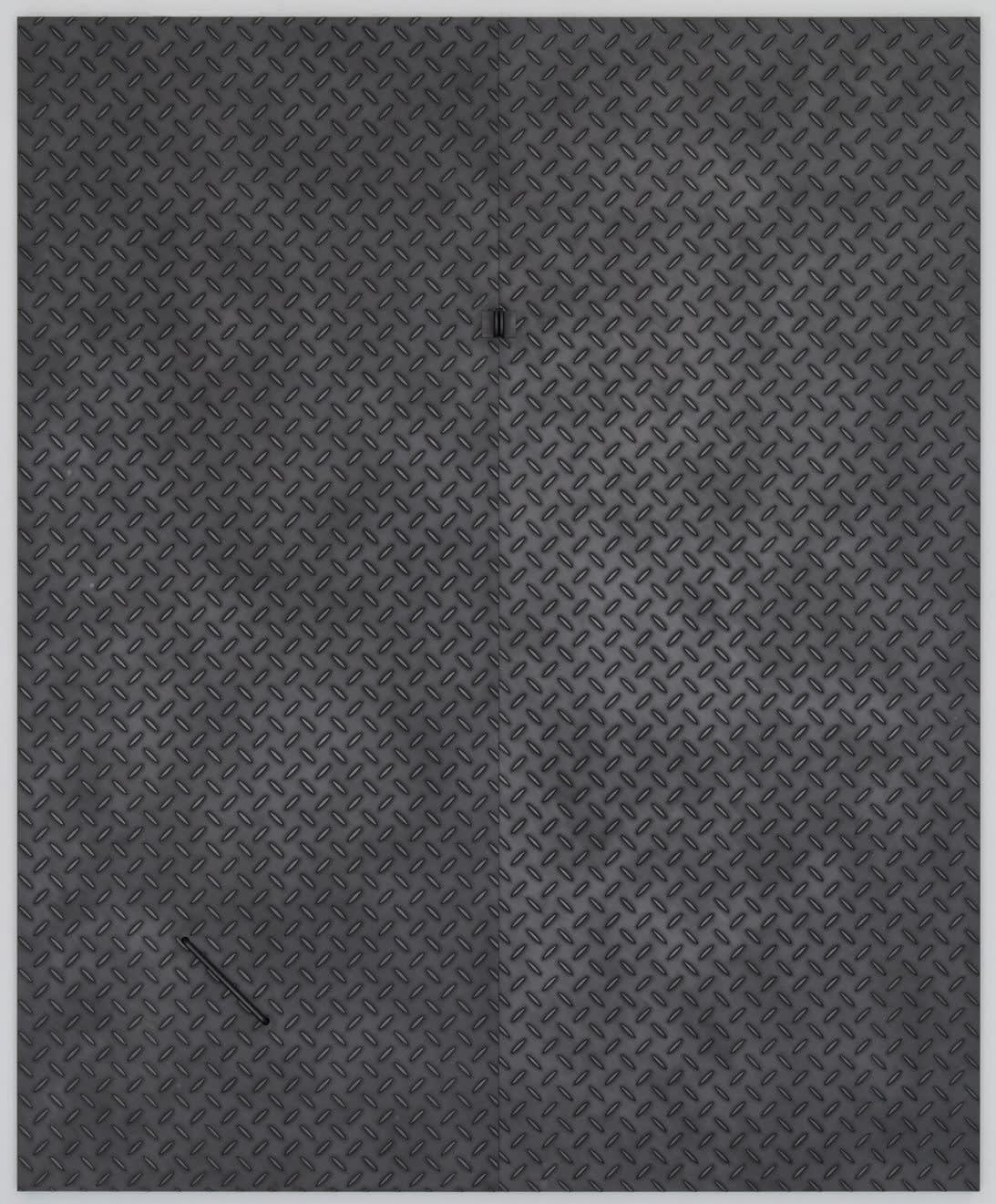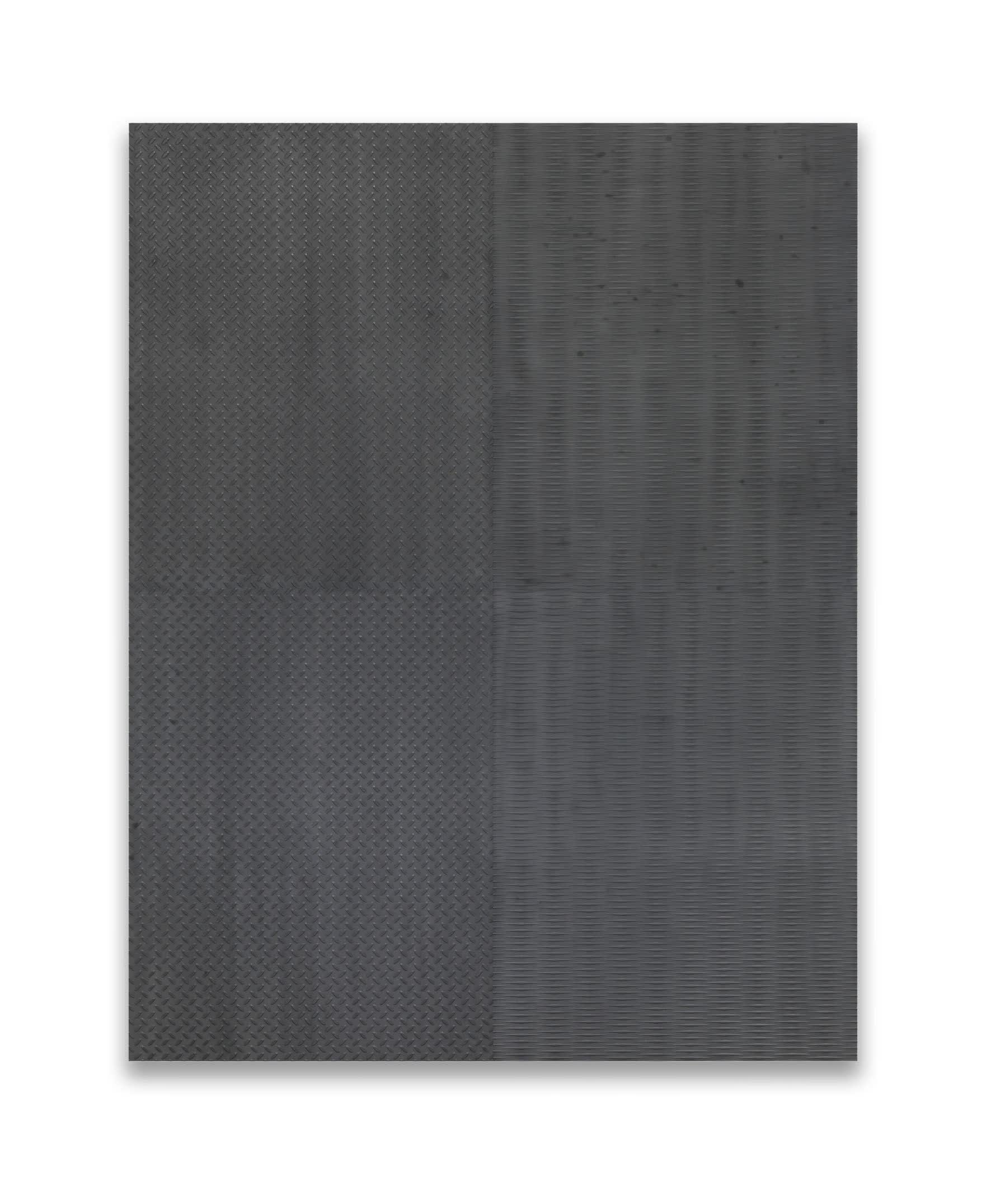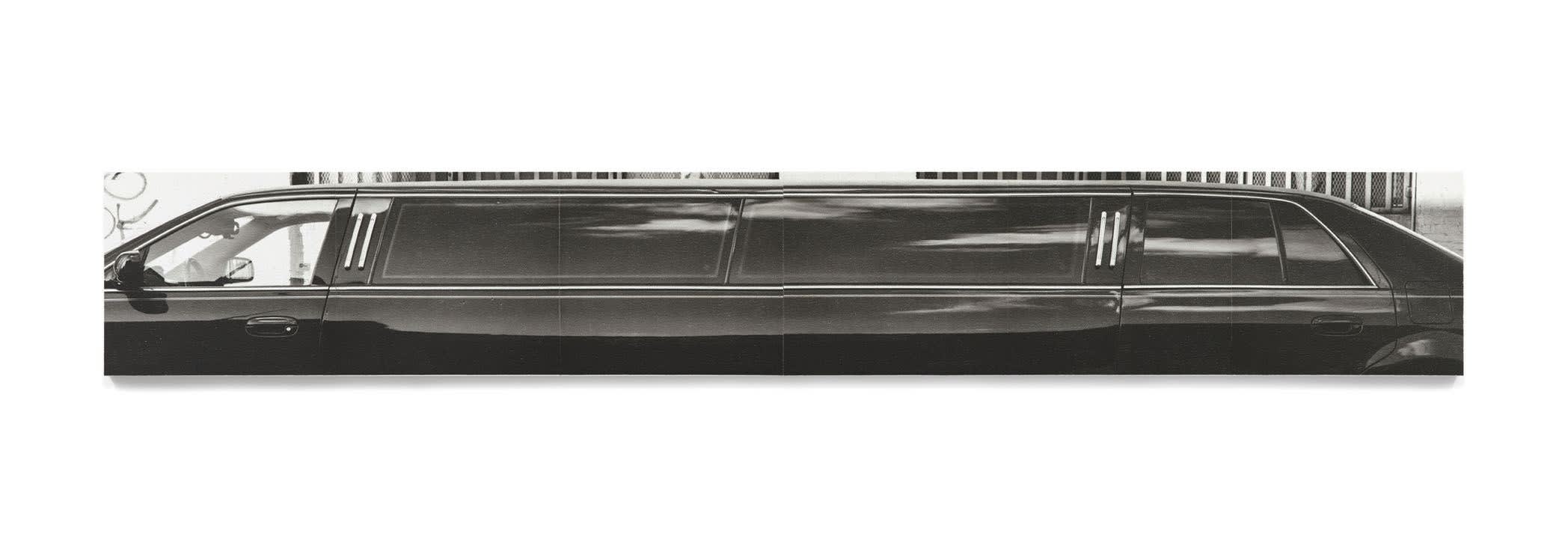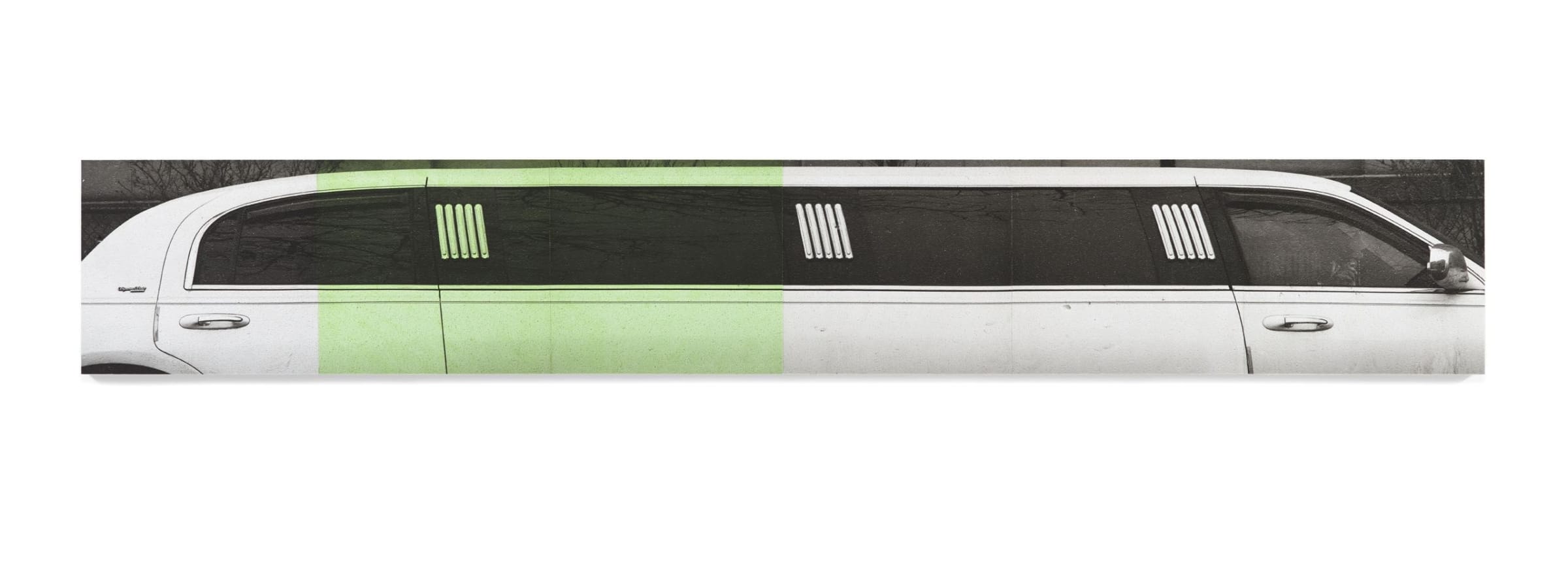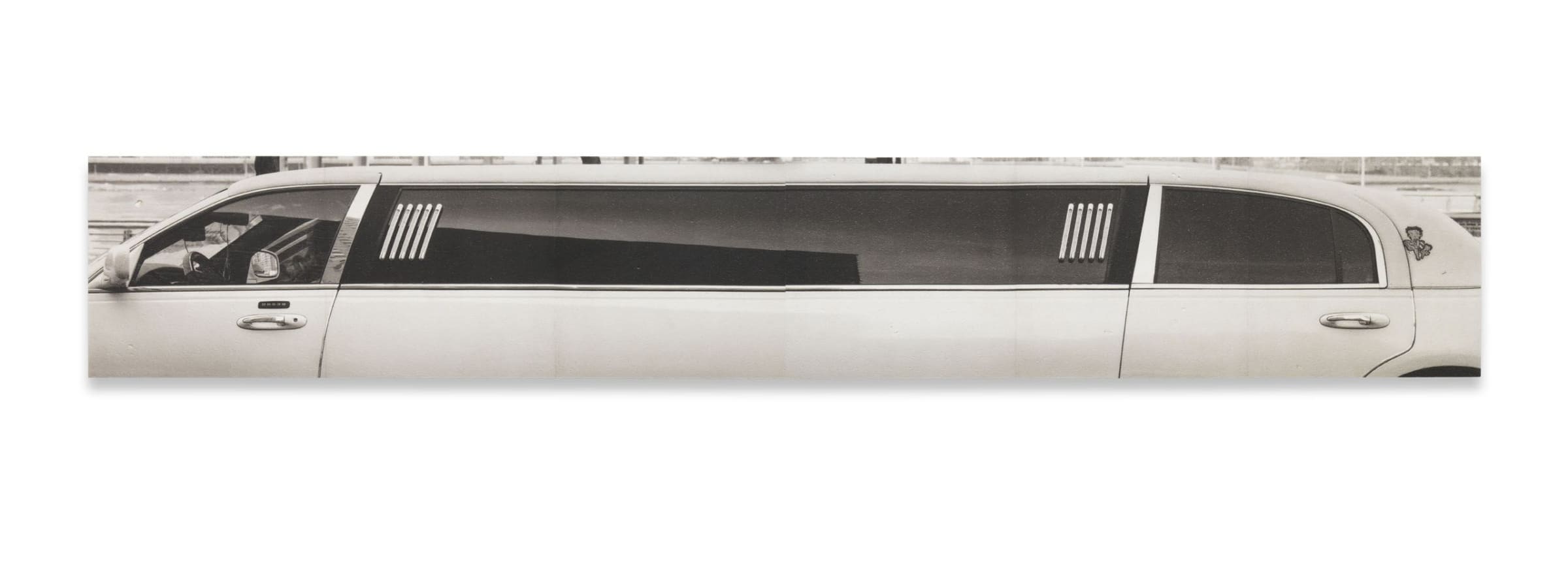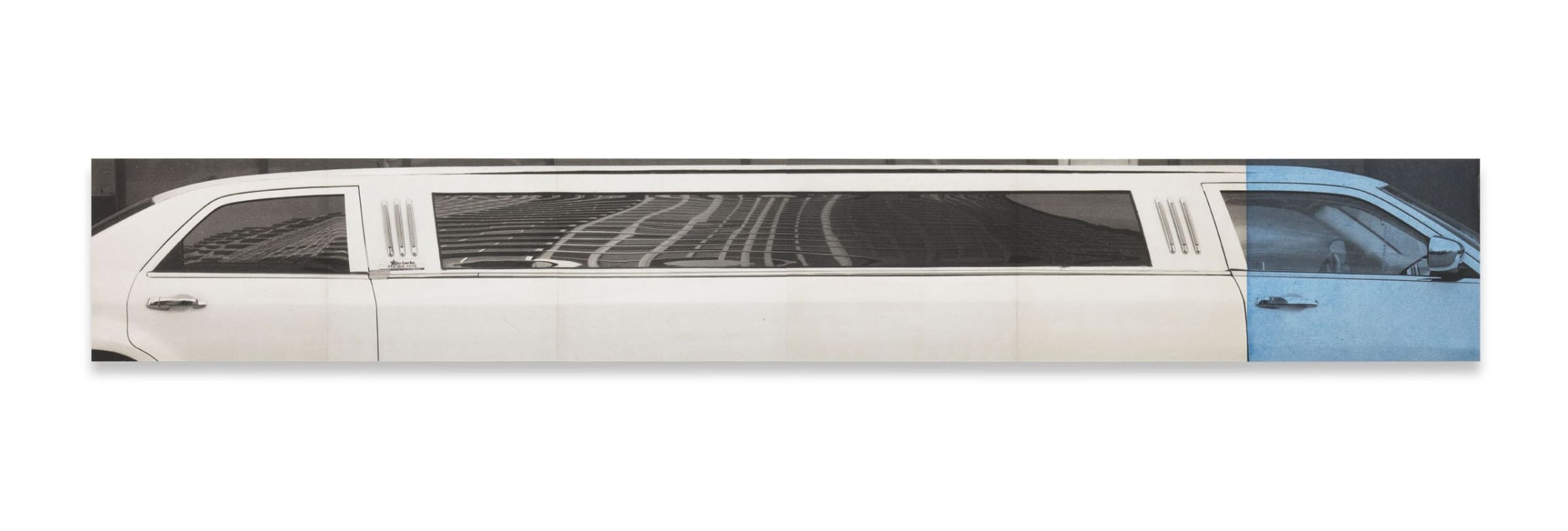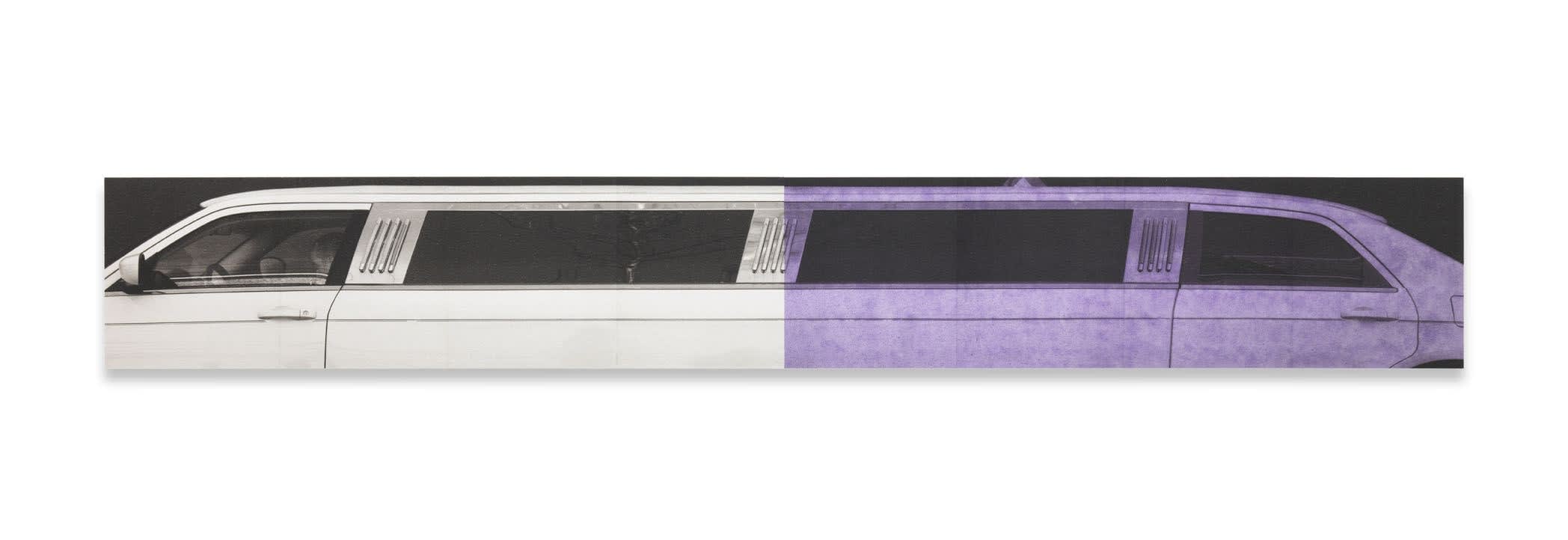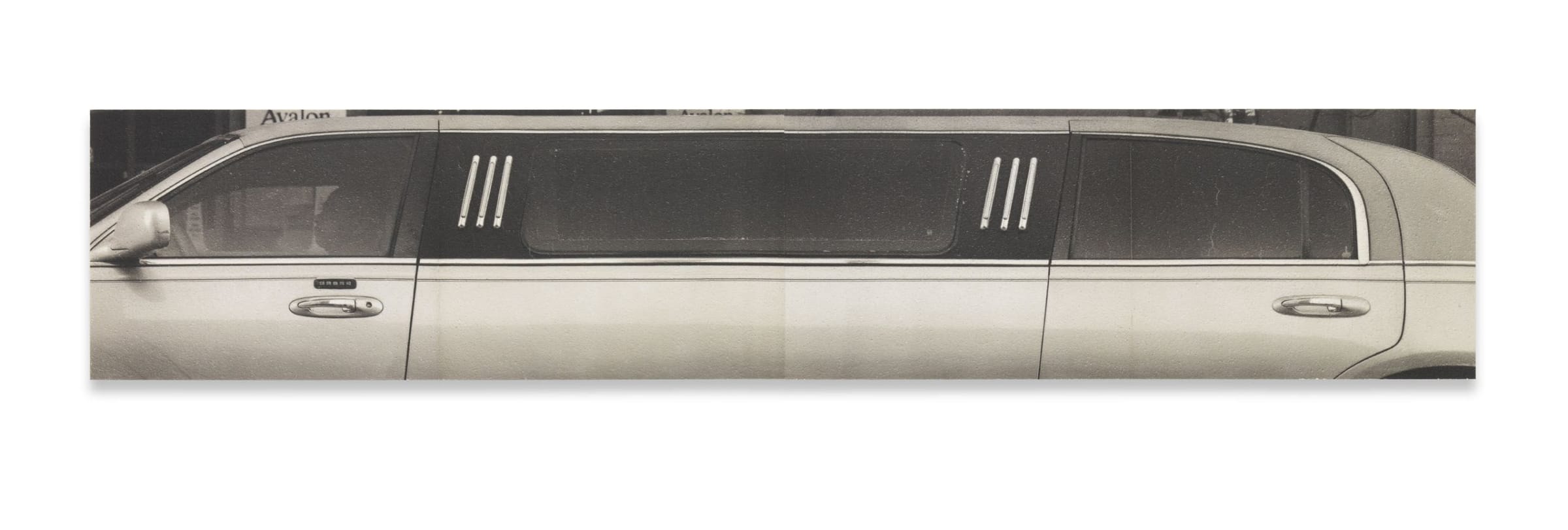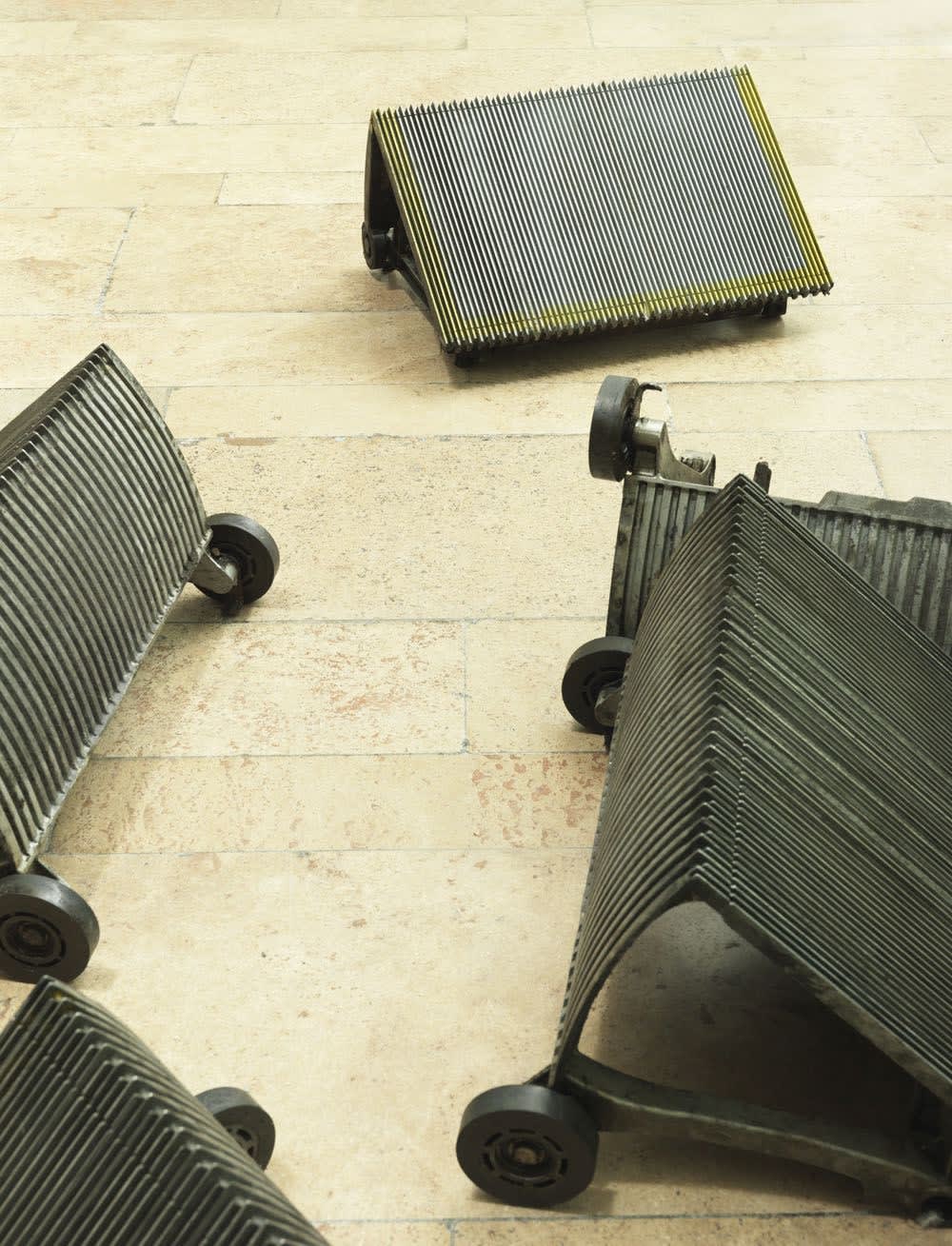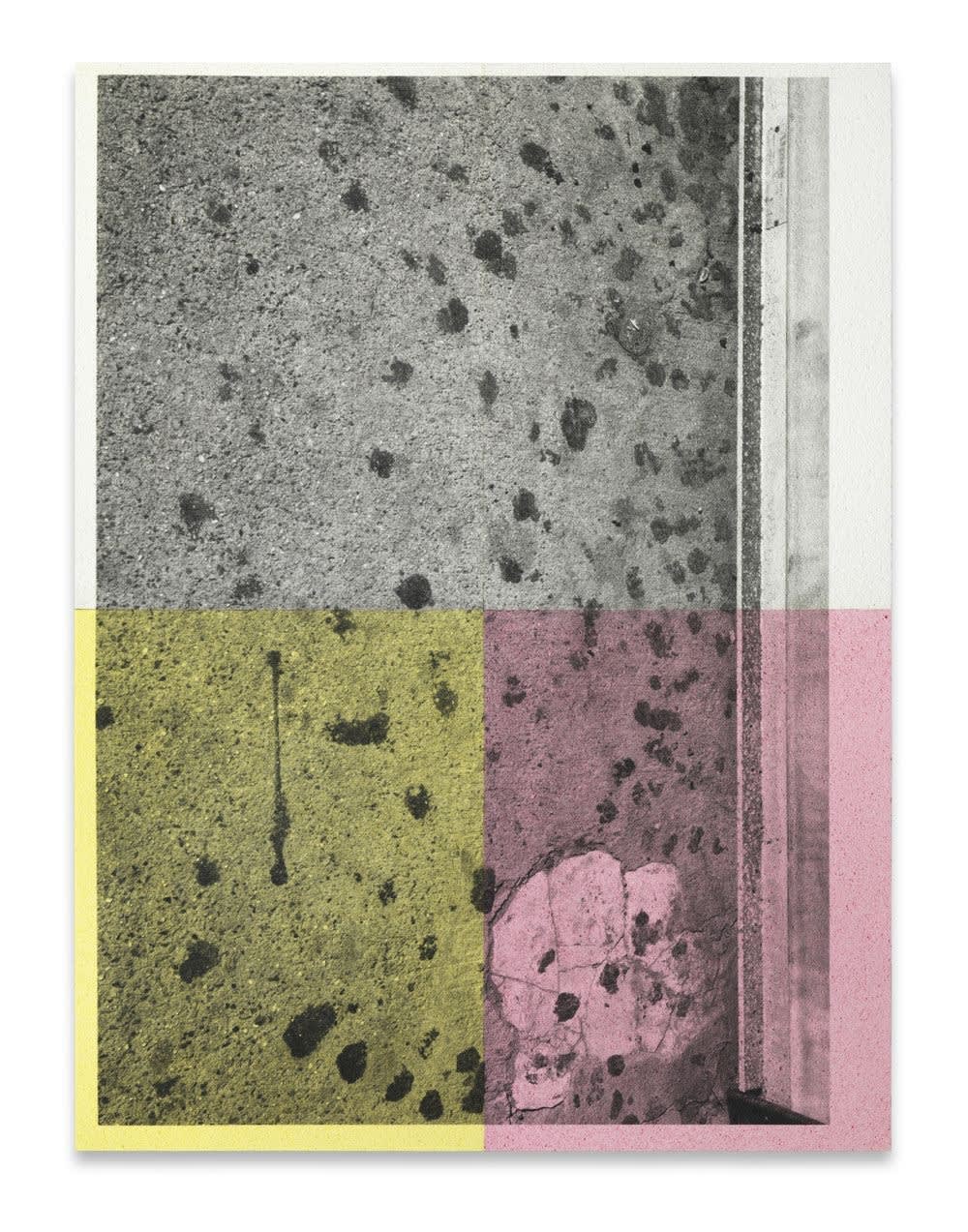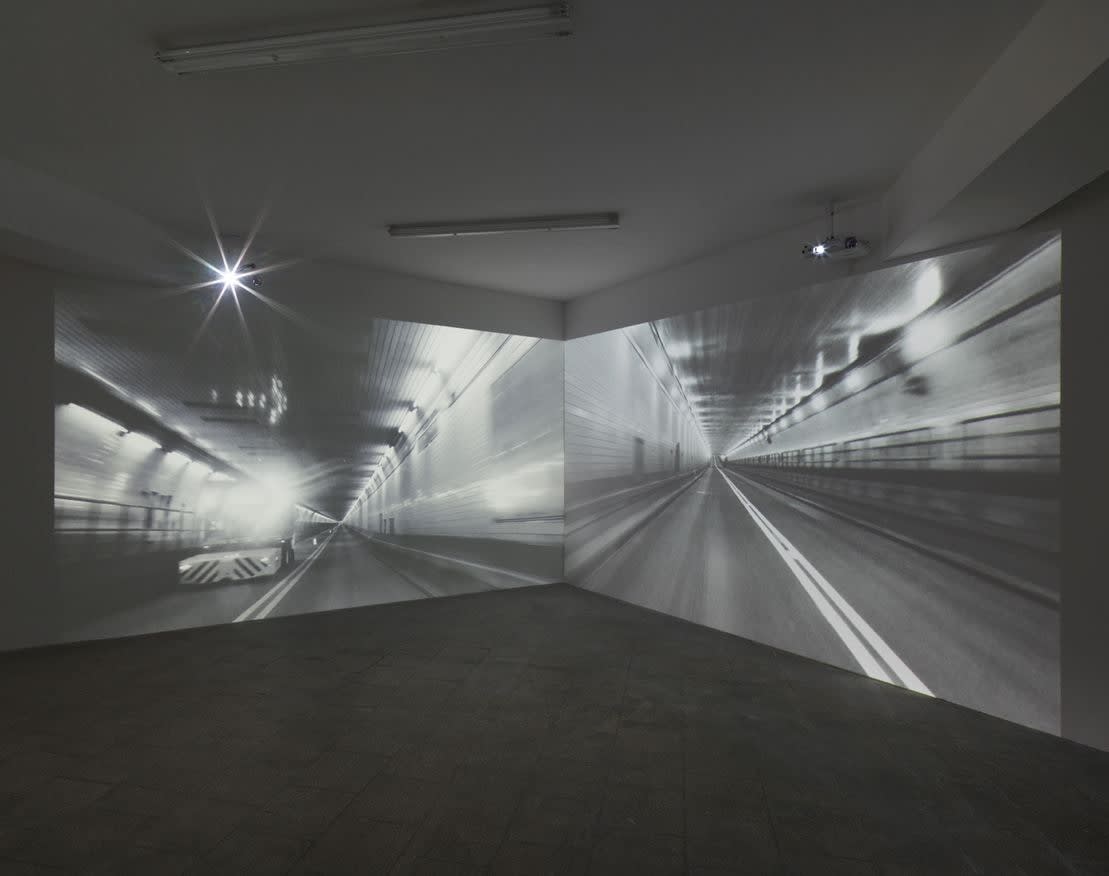Adam McEwen: Factory Tint
„Factory Tint“, the title of Adam McEwen’s first solo exhibition at Capitain Petzel, is a term taken from the car industry that refers to the percentage of window glass tinting or darkening. In the gallery’s main space fifteen life-size images of stretched limousines, inkjet prints on cellulose sponge, lean against the mezzanine.
In the context of a limousine, the term Factory Tint brings to mind the cars’ blacked out windows, darkened two-way mirrors which by preventing the person on the street from seeing who is inside, set up a power relationship between the interior and the exterior of the car. Part of the attraction of a stretched limousine, and the reason people rent them, is the promise of temporarily inverted power relations. The cars offer the illusion of escape – from work, from normality, from powerlessness. They exploit a certain kind of aspiration, while appearing to enable a temporary sense of movement: from normal life to a ‚special night‘. The word factory also highlights the work aspect. Each limousine piece is titled after the driver of the car: „Esteban“, „Big Mike“, „Adelson“, „Camillo“, „Fernando“, all 2014. These drivers are working by the clock. The body of the car promises pleasure, but at the cost of someone’s labor.
As former prestige objects, now seen as kitsch and debased, limousines function today only as a projection screen for fantasy. They look the way they look purely in order to trigger emotions in the viewer: desire, curiosity, intrigue, fear, wonder, disgust, mockery. These vehicles are absurd and ridiculous: phallic, unwieldy, attention-seeking, pathetic. Adam McEwen is intrigued by the sculptural presence of the limousines as they move through New York City: exaggerated, unreal and irrational objects, loaded with conflicting ideas – sculptures on wheels.
The main gallery hall also includes a number of used, ready-made escalator steps which together comprise an installation titled „Assembly“, 2014. Like the limousines, the escalator steps seem to promise movement; and like the limousines, they disappoint.
As one enters the lower ground floor of the gallery, one is surrounded and enclosed by pulsing images of movement through tunnels, a multiscreen installation titled „Escape from New York“, 2014. The work is named after the 1981 movie by John Carpenter, in which Manhattan has been turned into a high-security prison. Filmed on a smart phone, the projections take the viewer out of Manhattan through the four tunnels that connect the island with the mainland: the Lincoln Tunnel, the Holland Tunnel, the Battery Tunnel and the Midtown Tunnel. In each case, as the camera is about to exit the tunnel the film loops back to the beginning, so one never actually escapes.
Adam McEwen forms icons out of the everyday hardware of popular culture. By selecting and focusing on apparently mundane objects – a cash dispenser, an air conditioner, a luxury vehicle – and rendering them in familiar but unlikely materials such as graphite or sponge, he foregrounds the melancholy and fictional promises that underlie capitalism.
The exhibition is accompanied by an artist book.
Adam McEwen (b. 1965, London, UK) lives and works in New York. McEwen studied at Christ Church, Oxford and California Institute of the Arts, Valencia, CA.
McEwen exhibits internationally, selected solo exhibitions include: The Goss Michael Foundation, Dallas (2012); „11.11.11“, Gagosian Gallery, Beverly Hills (2011); „A Real Slow Drag“, Marianne Boesky Gallery, New York (2011); „The House of Marlon Brando“, Galerie Art: Concept, Paris (2011); „Switch and Bait“, Nicole Klagsbrun Gallery, New York (2009); McEwen has participated in numerous group shows across America and worldwide including those at: Indianapolis Museum of Art, Indianapolis; White Flag Projects, Saint Louis; Guggenheim Museum, Bilbao; Museum of Contemporary Art, Miami; Gavin Brown’s Enterprise, New York; P.S.1 Contemporary Art Center, Long Island City, New York; White Columns, New York; Gagosian Gallery, London and Beverly Hills; Hayward Gallery, London; Whitney Museum of American Art, New York; and CCA Wattis Institute for Contemporary Art, San Francisco.
McEwen has curated various projects and exhibitions including: „Fresh Hell, Carte Blanche à Adam McEwen“, Palais de Tokyo, Paris (2010); „Beneath the Underdog“ (with Nate Lowman), Gagosian Gallery, New York (2007), „Interstate“, Nicole Klagsbrun Gallery, New York (2005); and „Couldn’t Get Ahead“, Independent Art Space, London (1995).
-
„Factory Tint“, der Titel der ersten Einzelausstellung von Adam McEwen bei Capitain Petzel, ist ein Begriff aus der Autoindustrie, der sich auf den Grad der Fensterglasabdunkelung bezieht. Gegen die Ballustrade im Hauptraum der Galerie lehnen 15 lebensgroße Stretchlimousinen, deren Abbildungen aus Inkjet-Drucken auf Zelluloseschwämmen bestehen.
Der Begriff „Factory Tint“ verweist in Verbindung mit einer Limousine auf ihre dunkel getönten Autofenster. Da sie den Passanten den Blick ins Innere verwehren, bauen diese Einwegspiegel zwischen dem Innen und dem Außen des Autos eine Machtbeziehung auf. Ein Teil der Anziehungskraft von Stretchlimousinen, und der Grund für ihr Anmieten liegt in dem Verprechen einer temporären Umkehrung der Machtverhältnisse. Sie liefern die Illusion, es wäre möglich der Arbeit, der Normalität und der Machtlosigkeit zu entkommen, wobei sie auf die Sehnsucht anspielen – das Gleiten vom normalen Leben hin zu einer „besonderen Nacht“. Das Wort „Factory“ verdeutlicht darüber hinaus das Moment der Arbeit. Jede einzelne Limousine ist nach dem jeweiligen Fahrer des Wagens benannt: „Esteban“, „Big Mike“, „Adelson“, „Camillo“, „Fernando“, alle aus dem Jahr 2014. Im Gegensatz zu der Zusicherung von Vergnügen arbeiten diese Fahrer auf Stundenbasis.
Früher als Prestigeobjekte symbolisiert, werden die Limousinen heute als Kitsch angesehen und liefern lediglich eine illusorische Projektionsfläche einer bestimmten Phantasie. Ihre Erscheinung zielt darauf ab, Emotionen wie Begehren, Neugier, Faszination, Furcht, Erstaunen, Empörung oder Spott im Betrachter auszulösen. Diese Fahrzeuge sind absurd und lächerlich: phallisch, sperrig, Aufmerksamkeit heischend, pathetisch. Adam McEwen wurde von der skulpturalen Präsenz der Limousinen, die sich durch New York City bewegen, nachhaltig beeindruckt. Es sind übertrieben dimensionierte, unwirkliche und irrationale Objekte, die mit widersprüchlichen Vorstellungen besetzt sind – Skulpturen auf Rädern.
Eine Anzahl von tatsächlich ursprünglich genutzten Rolltreppenstufen bilden in der
Haupthalle der Galerie als Readymades eine Installation mit dem Titel „Assembly“ (2014). Ebenso wie die Limousinen scheinen auch die Rolltreppenstufen Bewegung zu verheißen – und ebenso wie die Limousinen enttäuschen sie diese Erwartung.
Im Untergeschoss der Galerie wird man von pulsierenden Bildern einer Fahrt durch mehrere Tunnel umschlossen; es handelt sich dabei um eine vierteilige Video-Projektion mit dem Titel „Escape from New York“ (2014). Dieses Werk ist nach dem Film von John Carpenter aus dem Jahr 1981 benannt, in welchem Manhattan in ein Hochsicherheitsgefängnis verwandelt wurde. Die auf einem Smartphone gefilmten Videos führen den Betrachter durch die vier Tunnel, die die Insel mit dem Festland verbinden, aus Manhattan heraus: durch den Lincoln Tunnel, den Holland Tunnel, den Battery Tunnel und den Midtown Tunnel. Immer wenn die Kamera den Tunnel gerade verlassen will, springt der Film wieder zum Anfang zurück, sodass man praktisch niemals entkommen kann.
Adam McEwen gestaltet Ikonen aus den alltäglichen Gebrauchsgegenständen der Populärkultur. Da er sich bei seiner Auswahl auf offenbar banale Objekte konzentriert – Geldautomat, Klimaanlage, Luxusfahrzeug – und diese in vertrauten, aber ungewöhnlichen Materialien wie Graphit oder Schaumstoff wiedergibt, rückt er die Melancholie und die fiktiven Versprechen in den Vordergrund, die dem Kapitalismus zugrunde liegen.
Zur Ausstellung erscheint ein Künstlerbuch.
Adam McEwen (geb. 1965 in London) lebt und arbeitet in New York. McEwen hat am Christ Church College, Oxford und am California Institute of the Arts, Valencia, Kalifornien, studiert.
Eine Auswahl Adam McEwens internationaler Einzelausstellungen: „The Sawney Bean“, The Modern Institute, Glasgow (2013); The Goss Michael Foundation, Dallas (2012); „11.11.11“, Gagosian Gallery, Beverly Hills (2011); „A Real Slow Drag“, Marianne Boesky Gallery, New York (2011); „The House of Marlon Brando“, Galerie Art: Concept, Paris (2011); „Switch and Bait“, Nicole Klagsbrun Gallery, New York (2009). McEwen hat an zahlreichen Gruppenausstellungen in ganz Amerika und auf der ganzen Welt teilgenommen, unter anderem: Indianapolis Museum of Art, Indianapolis; White Flag Projects, Saint Louis; Guggenheim Museum, Bilbao; Museum of Contemporary Art, Miami; Gavin Brown’s Enterprise, New York; P.S.1 Contemporary Art Center, Long Island City, New York; White Columns, New York; Gagosian Gallery, London and Beverly Hills; Hayward Gallery, London; Whitney Museum of American Art, New York, sowie CCA Wattis Institute for Contemporary Art, San Francisco.
McEwen hat verschiedene Projekte und Ausstellungen kuratiert, unter anderem „Fresh Hell, Carte Blanche à Adam McEwen“, Palais de Tokyo, Paris (2010); „Beneath the Underdog“ (mit Nate Lowman), Gagosian Gallery, New York (2007), „Interstate“, Nicole Klagsbrun Gallery, New York (2005), sowie „Couldn’t Get Ahead“, Independent Art Space, London (1995).
-
 Adam McEwen807 Lexington Ave., 2014Graphite93 x 102.9 x 5.4 cm
Adam McEwen807 Lexington Ave., 2014Graphite93 x 102.9 x 5.4 cm
36.6 x 40.5 x 2.1 inches -
 Adam McEwenGlenn Gould, 2014Graphite on aluminum panel142.2 x 116.8 x 3.8 cm
Adam McEwenGlenn Gould, 2014Graphite on aluminum panel142.2 x 116.8 x 3.8 cm
56 x 46 x 1.5 inches -
 Adam McEwenSav-on, 2014Graphite on aluminum panel228.6 x 177.8 cm
Adam McEwenSav-on, 2014Graphite on aluminum panel228.6 x 177.8 cm
90 x 70 inches -
 Adam McEwenMatty, 2014Inkjet print on cellulose sponge, mounted on aluminum back-frame444.5 x 76.2 cm
Adam McEwenMatty, 2014Inkjet print on cellulose sponge, mounted on aluminum back-frame444.5 x 76.2 cm
175 x 30 inches -
 Adam McEwenEsteban, 2014Inkjet print on cellulose sponge440.7 x 76.2 cm
Adam McEwenEsteban, 2014Inkjet print on cellulose sponge440.7 x 76.2 cm
173.5 x 30 inches -
 Adam McEwenBig Mike, 2014Inkjet print on cellulose sponge522 x 83.8 cm
Adam McEwenBig Mike, 2014Inkjet print on cellulose sponge522 x 83.8 cm
205.5 x 33 inches -
 Adam McEwenCarlos, 2014Inkjet print on cellulose sponge524 x 81.3 cm
Adam McEwenCarlos, 2014Inkjet print on cellulose sponge524 x 81.3 cm
206.3 x 32 inches -
 Adam McEwenFernando, 2014Inkjet print on cellulose sponge558.8 x 83.8 cm
Adam McEwenFernando, 2014Inkjet print on cellulose sponge558.8 x 83.8 cm
220 x 33 inches -
 Adam McEwenTommy, 2014Inkjet print on cellulose sponge504.2 x 88.9 cm
Adam McEwenTommy, 2014Inkjet print on cellulose sponge504.2 x 88.9 cm
198.5 x 35 inches -
 Adam McEwenGeorge, 2014Inkjet print on cellulose sponge530.9 x 81.3 cm
Adam McEwenGeorge, 2014Inkjet print on cellulose sponge530.9 x 81.3 cm
209 x 32 inches -
 Adam McEwenJim, 2014Inkjet print on cellulose sponge555.8 x 85.1 cm
Adam McEwenJim, 2014Inkjet print on cellulose sponge555.8 x 85.1 cm
218.8 x 33.5 inches -
 Adam McEwenAndrew, 2014Inkjet print on cellulose sponge683.3 x 86.4 cm
Adam McEwenAndrew, 2014Inkjet print on cellulose sponge683.3 x 86.4 cm
269 x 34 inches -
 Adam McEwenArelis, 2014Inkjet print on cellulose sponge528.3 x 83.8 cm
Adam McEwenArelis, 2014Inkjet print on cellulose sponge528.3 x 83.8 cm
208 x 33 inches -
 Adam McEwenFranklin, 2014Inkjet print on cellulose sponge551.2 x 80.6 cm
Adam McEwenFranklin, 2014Inkjet print on cellulose sponge551.2 x 80.6 cm
217 x 31.75 inches -
 Adam McEwenJimmy, 2014Inkjet print on cellulose sponge287 x 76.2 cm
Adam McEwenJimmy, 2014Inkjet print on cellulose sponge287 x 76.2 cm
113 x 30 inches -
 Adam McEwenMichael, 2014Inkjet print on cellulose sponge328.9 x 83.3 cm
Adam McEwenMichael, 2014Inkjet print on cellulose sponge328.9 x 83.3 cm
129.5 x 32.8 inches -
 Adam McEwenCamillo, 2014Inkjet print on cellulose sponge320 x 86.4 cm
Adam McEwenCamillo, 2014Inkjet print on cellulose sponge320 x 86.4 cm
126 x 34 inches -
 Adam McEwenAnton, 2014Inkjet print on cellulose sponge, mounted on aluminum back-frame558.8 x 78.7 cm
Adam McEwenAnton, 2014Inkjet print on cellulose sponge, mounted on aluminum back-frame558.8 x 78.7 cm
220 x 31 inches -
 Adam McEwenAdelson II, 2014Inkjet print on cellulose sponge389.9 x 76.2 cm
Adam McEwenAdelson II, 2014Inkjet print on cellulose sponge389.9 x 76.2 cm
153.5 x 30 inches -
 Adam McEwenAssembly, 201415 Escalator steps (made in USA)variable dimensions
Adam McEwenAssembly, 201415 Escalator steps (made in USA)variable dimensions -
 Adam McEwenUntitled, 2014Inkjet print on cellulose sponge78 47/84 x 59 1/16 inches
Adam McEwenUntitled, 2014Inkjet print on cellulose sponge78 47/84 x 59 1/16 inches
200 x 150 cm -
 Adam McEwenUntitled, 2014Inkjet print on cellulose sponge200 x 150 cm
Adam McEwenUntitled, 2014Inkjet print on cellulose sponge200 x 150 cm
78.7 x 59.1 inches -
 Adam McEwenEscape from New York, 20144-Channel Video ProjectionLooped, Varying Lengths
Adam McEwenEscape from New York, 20144-Channel Video ProjectionLooped, Varying Lengths
Lincoln Tunnel: 02:20 min
Holland Tunnel: 02:43 min
Battery Tunnel: 02:33 min
Midtown Tunnel: 03:51 minEdition 1/3, 1 AP

